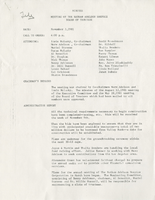Search the Special Collections and Archives Portal
Search Results
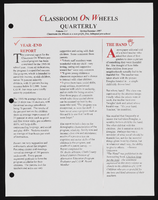
Classroom on Wheels fliers
Date
Archival Collection
Description
From the Alpha Kappa Alpha Sorority, Incorporated, Theta Theta Omega Chapter Records (MS-01014) -- Chapter records file.
Text
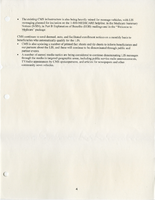
Kent Carmichael oral history interview
Identifier
Abstract
Oral history interview with Kent Carmichael conducted by Stefani Evans on November 25 and December 2, 2019 for the Boyer Early Las Vegas Oral History Project.
In the first session of this oral history, Carmichael discusses his early career in lighting design and maintenance from his start at Interstate Neon to his work in the 1950s and 60s in Las Vegas. He discusses some of the iconic signs he built including the Casino Center, Carnival Room, Thunderbird, The Frontier, Bonanza, and the Stardust. He also details the technology and inner workings of these innovative signs including the transition from mechanical to electrically controlled signage. Carmichael continues to discuss Native American laborers and various individuals that he interacted with throughout his early career including Max and Mo Oggenblick, Doby Doc, Benny Binion, Arby Alper, Steve Wynn, Peter Arp, and Wayne and Jerry Newton. Carmichael ends the first interview by recalling a high wind event that damaged the Frontier sign and his efforts to bring the sign under control and repair it as well as his vision and behind the Stardust sign.
The second oral history interview contains Carmichael’s discussion of his career from 1968 onward. He immediately picks up discussion of the Stardust sign and his transition to desk work. Carmichael details the challenge and limitations of designing the International sign (the Westgate as of 2021). He describes the development of his first messenger sign for the International and the time consuming task of using tape to program the sign. He fondly remembers working on the Holiday Inn Riverboat signs, and International transition to Las Vegas Hilton and the Hilton’s transition from blue to red letters. Carmichael shares the story of being caught between organized crime and a young Steve Wynn. He recounts his last project for Ad Art, developing and construction the sign for the Louisiana Superdome in New Orleans, Louisiana. He details working through legislative and construction issues as well as the fallout from the Nat Kiefer Commission.
After leaving Ad Art Carmichael began working with Heath and Co. and began collaborating with Raul Rodriguez. Carmichael and Rodriguez went on to design some of the most enduring and visually unique signs in Las Vegas including, the Flamingo, Four Queens, Golden Nugget, Dunes Hotel, and the Desert Inn. They also worked in Reno on Circus Circus and El Dorado. Carmichael also details his interior work including the main pylon and interior signs for MGM Grand; 1974 renovation Golden Nugget, suspended stained glass ceiling at Tropicana, and the MGM Lion display. Lastly Carmichael outlined his work with Young Electric Sign 1983-85 and the Dewey Sign Company including the Las Vegas Convention Center sign. He ends by sharing his views on the role and importance of lighting in Las Vegas.
Archival Collection

Transcript of interview with Michael J. Signorelli by Claytee D. White, Stefani Evans, August 4, 2016
Date
Archival Collection
Description
Michael Signorelli, long-time Las Vegas resident and builder of many local homes, apartments and hotels, describes his upbringing, career, and stellar reputation as part of the “Building Las Vegas” oral history project. Raised in Rhode Island, the only child of an Italian-American father and a Southern Baptist mother, Michael’s early life was influenced by his father’s disability as a World War Two veteran and his non-English speaking paternal grandparents, who owned and ran a grocery store. Talking of his experiences in helping them run the grocery store he says, "I became a businessman at the age of twelve." His military service during the Vietnam War landed him at Nellis Air Force Base in Las Vegas. Once here, Michael furthered his education at UNLV, obtaining both his MEd and PhD degrees. In Las Vegas Michael began his work in the housing arena working for Sun Home Builders and his non-profit work, helping to raise funds for the newly formed Rape Crisis Center. Signorelli went on to work for Howard Hughes's Summa Corporation, where he successfully fought against a discrimination lawsuit brought by twenty-one female dealers. In 1978 Michael started his own company, Nicro Corporation, and began building homes in the Las Vegas valley with land he acquired on a hand-shake and a verbal contract. He continued his non-profit work, which included coordinating Lady Bird Johnson’s Green Thumb project for Nevada and the Pacific Northwest. In the 1980s Signorelli was recruited by the Fitzgerald Group, where he was involved in non-gaming operations for their many hotels, cattle ranch, and an in vitro clinic. In this interview, Signorelli describes his non-Las Vegas building projects in Mesquite and Laughlin. He built the Mesquite Star hotel and casino by overcoming multiple hurdles around water access and money. Despite twice obtaining a loan for one hundred million dollars, he was never able to successfully complete the Laughlin hotel and casino, due to legal issues from his partner’s family trust. Signorelli also shares his idea for a unique hotel and casino called the Nev Star that involved his successful negotiation of a waiver to Senate Bill 208. Signorelli concludes his interview by talking about his ownership of the world-famous Golden Steer Steak House restaurant, which opened in 1958. Under Signorelli’s ownership the Golden Steer has been featured in national publications and claims many legendary fans such as NACAR driver Mario Andretti, who in 2016 celebrated his seventy-six birthday at the Golden Steer. Signorelli’s love of Las Vegas and its many positive traits come forth as he talks about his daughter and her achievements and suggests Vegas promoters should do a better job about what great schools, medical care, and government we have in Las Vegas.
Text
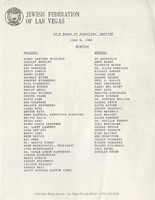
Jewish Federation correspondence, meeting minutes, and other records, item 19
Description
Jewish Federation of Las Vegas (JFLV) Board of Directors' Meeting minutes, June 8, 1988.
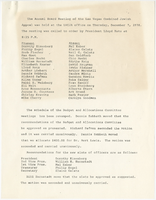

Transcript from interview with Rabbi Yocheved Mintz by Barbara Tabach, March 11, 2015
Date
Archival Collection
Description
During this oral history, Rabbi Yocheved Mintz weaves the journey of her life before and during her move to Las Vegas. She recalls thinking the "whole world was Jewish" growing up in Cleveland, Ohio, and discusses finding a community in Las Vegas, and becoming a rabbi in 2004.
Yocheved (nee Porath) Mintz is a native of Cleveland, Ohio, where she grew up surrounded by Jewish tradition and teachings. Her grandfather was Rabbi Israel Porath and inspiration to become the family?s first female rabbi. She was ordained in May 2004. The next year she became the second spiritual leader of Valley Outreach Synagogue, now known as P?nai Tikvah. She soon was known as a tireless and inspirational rabbi for the entire Jewish community of Las Vegas. After eleven years, on June 17-18, 2016, Rabbi Mintz?s life and dedication to being Jewish were celebrated. She transitioned to be Rabbi Emerita/Senior Educator. Before moving from Chicago to Las Vegas in 1999 she was abundantly busy with raising four sons she had with her husband the late Dr. Alan Mintz (1938-2007). However, she also managed to pursue her education, become an interior designer, and co-found with her friend Etty Dolgin, a Jewish education consulting firm called Kesher Team. Yet there was a lingering goal to become a rabbi. Throughout her life, Yocheved eagerly studied various approaches to living a Jewish life. So once she had settled into Las Vegas, she began her commute to Los Angeles to study at the Academy for Jewish Religion, a trans-denominational seminary. She interned at Temple Beth Sholom and has been involved in Jewish education locally and nationally. She has served as the first president of the Las Vegas Board of Rabbis and on the Interfaith Council of Southern Nevada.
Text
Lori Lipman Brown Papers
Identifier
Abstract
The Lori Lipman Brown Papers date from 1975 to 2009 and document former Nevada State Senator Lori Lipman Brown's political career. It includes correspondence and materials from Brown's service as a Nevada State Senator from 1992 to 1994, case files from her defamation lawsuit against Nevada State Senator Kathy Augustine, and papers from her work opposing the Nevada Question 2 ballot measure on same-sex marriage in 2000. The collection also contains photocopies of biographical materials and personal and publicity photographs of Brown, as well as material from her time working with local high school and commmunity theatre programs.
Archival Collection


